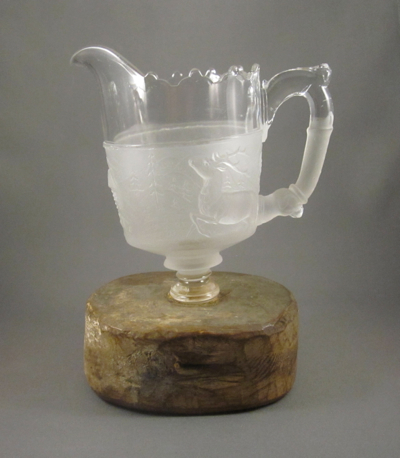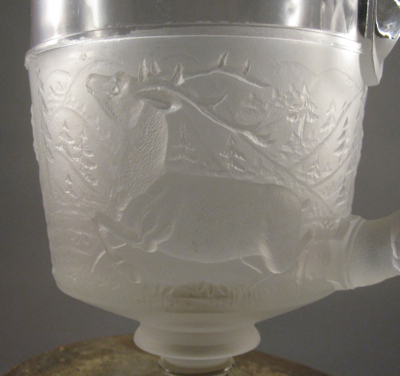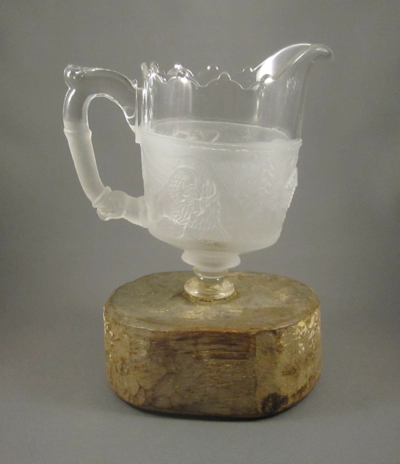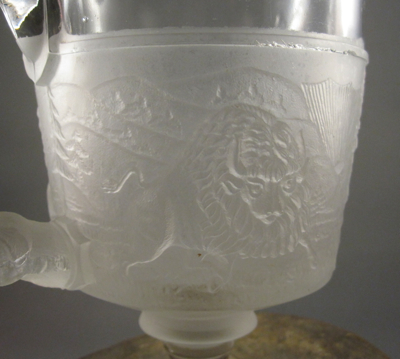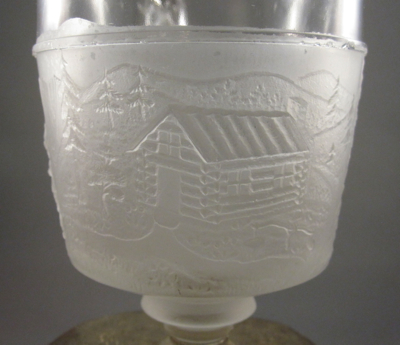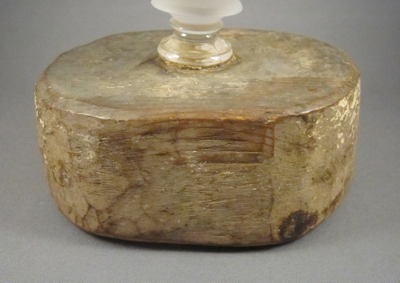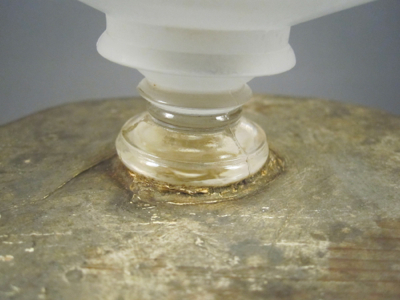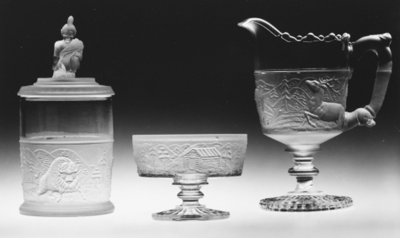Wishing you all the best during the holiday season and for a healthy and Happy New Year!
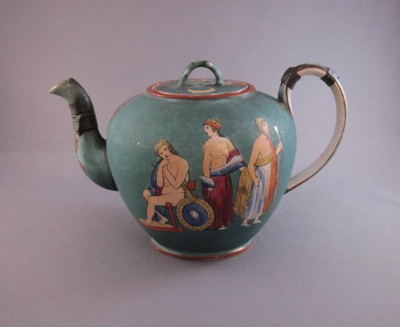
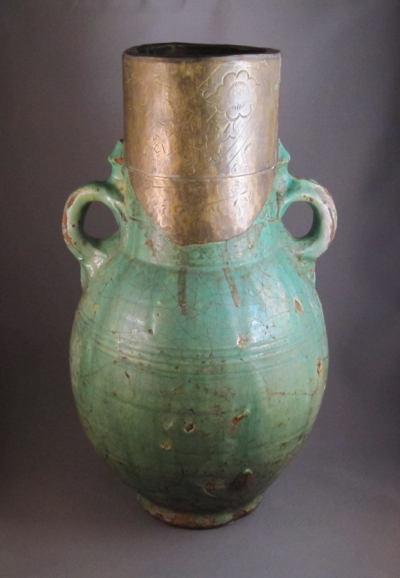
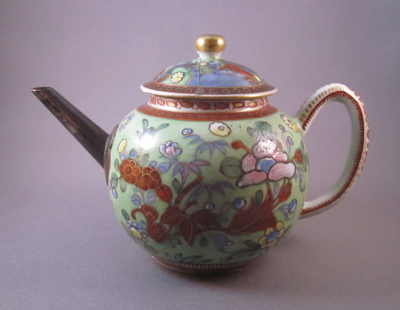
Tags:Chinese, clobbered, English, German, glass, globular, metal base, miniature, porcelain, pottery, silver, staples/rivets, wood base
Posted in bowl/dish, chocolate/coffee pot, cup/saucer, jug, plate/platter, teapot, toy, vase/vessel | 8 Comments »
This porcelain helmut-shaped cream jug, decorated in the Imari palette of blue, iron red and gilt, stands 4-1/4″ tall. It was made in China during the Qianlong period (1736-1795.) The hand painted decoration of floral sprigs and alternating blue panels suggests it was made for export to the Persian market.
At one point in its early life, the original porcelain handle snapped off, leaving it impossible to gracefully pass the cream at the dining table. It was brought to a tinker or metalsmith who fashioned this ornate replacement handle, possibly repurposed from an existing silver item. The delicate silver replacement is more ornate than the original branch-form handle, but adds just the right touch of class and whimsy.
The center jug, with similar form and decoration, shows what the original handle on my jug might have looked like.
Photo courtesy of Christie’s
Tags:Chinese, Imari, metal handle, porcelain, Qianlong
Posted in jug | 3 Comments »
This early black-brown salt glazed stoneware pewter-mounted Birnkrug “pear jug” was made in Annaberg, Germany in the second half of the 17th century. It has incised scaled body decoration of stylized relief palmettes and leaf ornamentation divided by applied molded borders, the front with a figure of Jesus. It is embellished in polychrome enamels and gilding, which have remained surprisingly vibrant after over 330 years. The hinged pewter lid is connected to a ball thumb piece and inset with what appears to be a coin with a crucifixion scene.
As rare as this 10″ high jug is, it is even more special to me by possessing a pewter replacement handle, added by an 18th century tinker, most likely in Germany, after the original handle broke off. The delicate handle, with an intricate stippled wave design and border, is supported by a mounted pewter base ring and lid collar. I first saw this pricy jug at an antiques shop over one year ago and passed on it. But I recently stopped by the shop again and was delighted to find that no one else had snatched it up. After a brief bargaining session with the friendly dealer, I was finally was able to purchase this gem and add it to my collection.
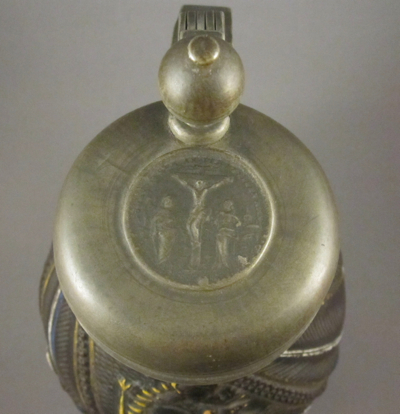
This jug of similar form and decoration still has its original handle.
Photo courtesy of Bonhams
Tags:German, metal base, metal handle, pewter, pottery, salt glaze, stoneware
Posted in jug | No Comments »
This Chinese baluster shaped porcelain jug, with molded spout in the manner of European silver, has hand painted underglaze cobalt blue Nanking decoration of houses, trees and birds. It dates from the middle of the 18th century and stands nearly 8″ tall.
Over 100 years ago when the original reeded strap handle broke off, an unusual split form metal replacement handle was added. A clever tinker reinterpreted the original handle design by forging a bronze loop handle into four extensions and adding small discs, which were riveted to the leaf terminals. The remains of an intricately woven rattan sheath are found on about one third of the handle. Most curiously, there is an engraved signature on the underside, difficult to decipher, which may be the name of the china mender or of a previous owner. If anyone knows more about this marking, please let me know.
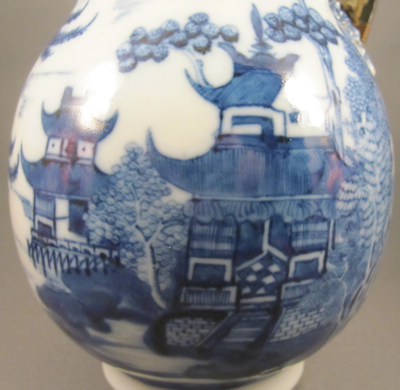
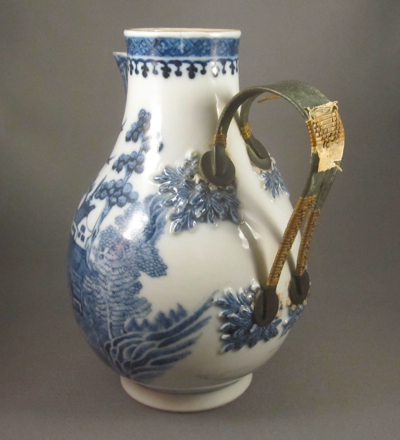

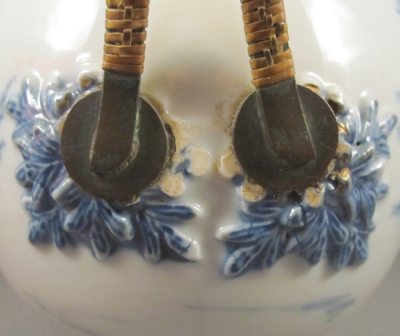
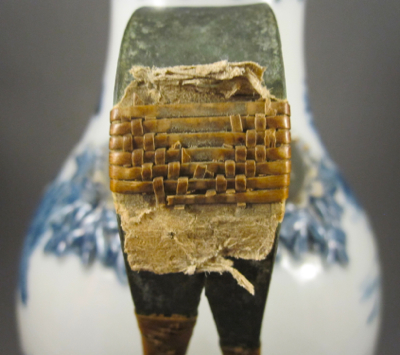
This jug with similar form and decoration shows what the original handle on my jug may have looked like.
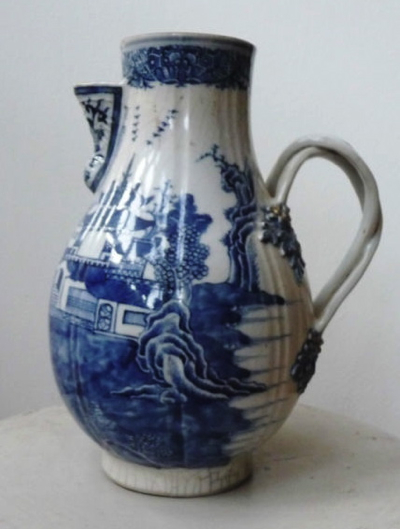
Photo courtesy of eBay
Tags:blue & white, bronze, Chinese, metal handle, porcelain, rattan
Posted in jug | 2 Comments »
This Teniers shape footed porcelain jug was made in Burslem, Staffordshire, England by Royal Doulton, 1892-1902. The bold transfer decoration in the Galleon pattern is printed in black with hand painted washes of mustard and aqua. This popular nautical scene appears on other forms, including vases and tobacco jars, and is clearly stamped in black on the underside DOULTON, BURSLEM, ENGLAND, GALLEON. Jug measures 7 inches high and 7 inches wide.
After this heavy jug slipped through the hands of an earlier owner, breaking its handle into four pieces, it was taken to a tinker (or china mender) who reattached the sections using five wide metal cuffs. Rather than leave the unfinished metal repairs to detract from the allure of the jug, the bands were painted in enamels to match the color and decoration of the handle. Although the color on the repairs has mellowed with age, the result still holds up and continues to be effective.
The Dalton Lambeth Galleon jug shown here has a different coloration and a perfect handle.
Photo courtesy of eBay
Tags:English, metal handle, porcelain, transferware
Posted in jug | 3 Comments »
This wonderfully graphic black transfer printed creamware jug, of ovoid form with loop handle, was most likely made in Liverpool, England, at the turn of the nineteenth century. It stands 7-3/4″ tall and is 8-1/4″ wide from handle to spout. Large jugs such as this were commonly found in fraternal lodges and used for dispensing alcohol after the main order of business was performed. One side is decorated with Masonic imagery and the verso is decorated with emblems and a verse from The Entered Apprentice’s Song. One night, over 100 years ago, a candidate was hoodwinked* during an especially tense initiation ritual and this jug must have fallen to the ground. Unable to repair the broken shards, a Mason brought it to a metalsmith, who fashioned a beautifully proportioned replacement spout, as well as a reinforcement rim and base. This is the first time I have come across a repair done in this fashion and I am impressed with the delicate craftsmanship. I also like how the color of the metal, which appears to contain some pewter, matches the color of the faded transfer print. *Hoodwink, which today means “to trick” or “to deceive,” was originally used in the Masonic Lodge to describe a blindfold. Hood means “cover” and wink means “closed eye.” A candidate was hoodwinked during an initiation ceremony as he was led through a room, unable to see, in order to focus on the words he was hearing. I bet many a make-do were born during such hypnotic rituals!
This jug with similar form and decorations shows what my jug would have looked like before it was repaired.
Photo courtesy of Skinner
Tags:creamware, English, metal handle, pottery
Posted in jug | 2 Comments »
This small pottery “Dutch” shape jug, decorated with black transfer prints and verses of the popular Sailors Farewell, was made in Sunderland, England, in the early to middle 1800s. Standing 6″ tall, it is embellished with polychrome overglaze washes and pink lustre accents. The front and rim have floral prints and the reverse side is decorated with a black transfer print of the poem A Birth-Day Thought, written in 1809 by Charles Lamb (1775-1834):
I envy no one’s birth or fame,
Their titles, train, or dress;
Nor has my pride e’er stretched its aim
Beyond what I possess.
I ask and wish not to appear
More beauteous, rich, or gay:
Lord, make me wiser every year,
And better every day.
Over one hundred years ago when the jug was dropped, resulting in the loss of the original loop handle, it was taken to a tinker who made a metal replacement. The owner must not have liked the incongruity of the raw metal handle strapped to the delicate ceramic jug, so the handle was painted in copper tones, to help ease the offensive blight.
This jug with similar form and decoration shows what the handle on my jug would have looked like with its original handle intact.
Photo courtesy of Carter’s
Tags:English, lustre, metal handle, pottery, transferware
Posted in jug | 1 Comment »
This large cream colored milk jug with sprigged decoration of hunters, horses and hounds was made in England in 1815 and bears the mark of the Chrysanthemum Factory, so-called because of the design of the pad mark on the underside. It was made by Charles Bourne and Chetham & Robinson and proved to be a popular design, as it was manufactured in many different forms, sizes and colors.
The striking dolphin shaped spout is minus its original lower half, replaced with a silver one by a tinker or jeweler long ago. It was expertly made as a cuff, snugly attached to the broken remains encased within. The ill-fitted lid, which came with the jug, seems to have been added at a later date by a previous owner. The jug stands 7-1/4″ tall without the lid.
Thanks to Benjamin Allen, whose Facebook group Sprigged & Relief Moulded Jugs helped to identify this piece.
This small cream jug gives you an idea of what the original spout on my larger jug looked like before it was brought to the tinker for repair.
Tags:English, metal spout, silver
Posted in jug | 8 Comments »
As much as I appreciate gorgeously painted porcelains with exquisitely crafted sterling silver repairs, I also get a thrill discovering stoic survivors such as this humble pressed glass jug. It was made in Philadelphia, Pennsylvania, by Gillinder & Sons in the late 1870s and stands 7-3/4″ tall. The acid etched “Westward Ho” pattern, originally called “Pioneer”, was so popular with consumers that it has been reproduced many times since its debut 135 years ago.
No surprise that in my opinion the best feature of this jug is its 4″ x 5″ clunky wood replacement base, which dates to the early 1900s. After it was attached to the intact upper body of the jug, it was painted white to appear more elegant. Although most of the whitewash has worn off, a warm patina remains on the out of proportion, crudely carved chunk of pine. Repairs of this kind were typically done at home using whatever materials were at hand. I imagine this jug was quickly repaired at father’s work bench, returned to the kitchen for mother to fill with cream, then brought to the dinner table to be passed back and forth between family members. Thanks to this sturdy, no-nonsense repair, it is still able to perform its original function over one hundred years later.
The jug at the right, from The Metropolitan Museum of Art’s collection, shows what the original footed base on mine would have looked like before it snapped off.
Photo courtesy of The Metropolitan Museum of Art
Tags:American, glass, wood base
Posted in jug | 10 Comments »
This pear shaped, ribbed cruet jug with beak spout was made in China in the mid 1700s for export to North America and Europe. It measures 4-3/4″ high and has hand painted cobalt blue underglaze decoration of cherry trees, floral sprigs and a fence. At one point in its early life, the original loop handle, set at a 45 degree angle to the spout, broke off. Some time in the late 18th or early 19th century it was taken to a metalsmith who fashioned a sturdy bronze replacement. The gilding, visible on the terminals only and not on the handle itself, indicates that it was originally wrapped with rattan. It amuses me to see paint speckles all over the jug and handle, suggesting that one of the owners neglected to cover their treasured items when they painted their room.
These three examples of similarly formed cruet jugs each have their original handles & lids.
Photo courtesy of Christie’s
Tags:blue & white, Chinese, metal handle, porcelain
Posted in jug | 2 Comments »
You are currently browsing the archives for the jug category.
Past Imperfect, The Art of Inventive Repair is proudly powered by WordPress
Entries (RSS) and Comments (RSS).
